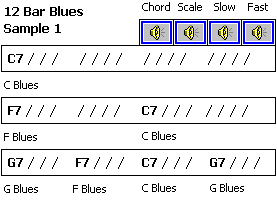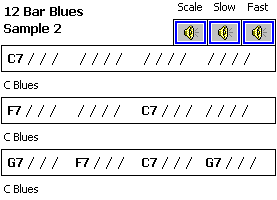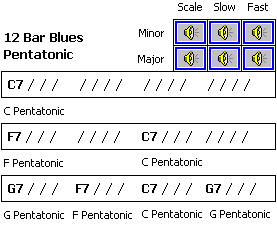(8.11) The Blues Exception
We have now developed a complete strategy for improvisation, based on the use of scales which are harmonically synchronised with the underlying chords. However, we can't finish this tutorial without covering one very important exception - the blues.
Blues is an overloaded term, referring to a scale, a chord progression format, and a musical flavour that appears in jazz, rock, soul and many other musical styles. What all of these have in common can be summarised as follows:
The blues is the combination of melody from a minor-based scale together with harmony from major or dominant-based chords.
This is revolutionary stuff. The entire theory of relations is built on chords and scales sharing the same set of notes. But if we mismatch them on the critical third (♭3/3) degree - which defines the essential major or minor sound - the results are actually pretty good.
This mismatch creates a compelling musical tension that can be played almost endlessly without going stale. It is very popular among casual musicians because it is easy to play, being based on simple chord progression formats and very few chord and scale types.
Here is your essential blues tool kit:

Looks too simple to be true? Let's see it in action. The absolute standard blues format is the 12 bar blues. A typical example is shown below, together with the Blues scale to be used over each chord.
The layout is similar to the previous samples, with buttons so you can hear the chords alone, or together with straight scales, slow improvisation or fast improvisation.

An even more interesting feature of the Blues scale is that you don't even need to change keys. You can just play the C Blues scale right through this progression, without losing too much musical interest. This is a winner for beginners!

Two other scales which are popular choices for playing blues are the Minor Pentatonic and Major Pentatonic scales.

Neither are quite as powerful as the Blues scale, but both are alternatives. The Minor Pentatonic is basically the Blues without the ♭5 degree, so it has a similar sound, but tamer.
The Major Pentatonic is similar to the Major scale, and since it contains a major (not minor) third degree, much of the blues tension is lost altogether. Compare their sound over the same 12 bar blues progression.














